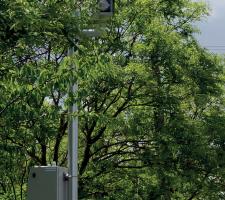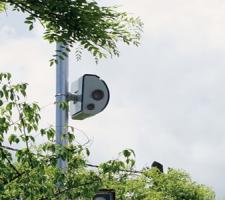
As red light enforcement is returning to some intersections and being shut down at others, new evidence has been released backing the safety campaigners, reports Jon Masters.
In 2014, 709 Americans were killed in red-light-running crashes and an estimated 126,000 were injured according to the
Following what it calls a comprehensive study, the IIHS published a report looking at the effects of turning off red light enforcement. The key findings were that per capita, the use of cameras reduced all types of fatalities at intersections by 14% and those caused by red light running were reduced by 21%. It also found that switching off enforcement cameras had the opposite effect with a 30% per-capita increase in red light fatalities and a 16% increase in all types of fatal crashes at signalised intersections.
That this study has been carried out at all is in itself is a reaction to a decade and more of continuous arguments for and against enforcement of traffic violations. The IIHS analysis is based on results from 14 cities that halted red light camera programs between 2010 and 2014. The total number of communities with intersection enforcement in place fell from a peak of 533 in 2012, to 467 by 2015, according to IIHS figures.
“We know we have a problem: people are dying at signalised intersections because of people running red lights. Red light cameras are part of the solution,” IIHS president Adrian Lund said as he presented the results of the new research at a red-light-camera forum hosted by the Institute in July.
Red light restart
Examples of red light enforcement programs being stopped and then restarted are numerous on what seems to be an endless merry-go-round of argument that continues for and against red light cameras. In the village of Wauconda in Lake County, Illinois, for instance, officials are proposing to reintroduce enforcement at an intersection where accidents have increased 36% since a construction project caused a red light camera to be removed in 2011.
This is according to the Chicago Daily Herald, which reports the figures as less than clear cut. While accident numbers at the Wauconda intersection jumped up in the year after the red light camera was shut down, they fell the following year in 2013 before rising again in 2014.
“This is by far our most dangerous intersection in town. To some, this [reintroducing cameras] may be an unpopular decision, but safety outweighs popularity,” Wauconda police chief David Wermes said, quoted in the Daily Herald.
In the city of El Mirage, Arizona, an increase in speeding and traffic collisions has been reported after enforcement systems were deactivated on the city’s Grand Avenue, which is part of the US 60 state highway. This comes after the passing of a new law in March this year, banning photo enforcement on Arizona’s arterial network.
Vocal minorities
Although the cameras have been turned off, traffic monitoring has continued and the recorded incidents of speeding have increased 179% on the westbound lanes of Grand Avenue and by 319% in the eastbound direction, according to the city’s published data.
“The data is clear. Without the camera deterrent, we are seeing more and more unsafe driving along Grand Avenue. This is an extremely serious matter, as lives are at stake,” said El Mirage police chief Terry McDonald in a statement.
The passing of Arizona’s state highways photo enforcement ban – passed amid protests staged against use of speed and red light cameras – plus numerous comments posted in response to published media reports, show that vociferous views remain.
“Wherever red-light safety cameras are found, there is a vocal minority of people who oppose them,” says Charles Territo, spokesman for enforcement services vendor
“It’s unfortunate, but sometimes the vocal minority win. As history has shown, victory for the camera opponents can come despite expert opinion from police chiefs, safety advocates, victims’ families and even public support in the communities where automated enforcement is used.”
Territo points to a number of other examples where a reversal is happening; where a realisation of rising road deaths due to speeding and red light running is bringing the cameras back into use.
A number of cities in Northern Virginia, for instance, have chosen to reactivate traffic enforcement programs after police forces successfully lobbied the state for a bill to put the necessary legislative powers back in place. This came after Northern Virginia had previously voted to not renew its camera programs just two years earlier.
Crash types critical
The second reversal in favour of allowing traffic enforcement followed a study by the Virginia Department of Transportation and the Federal Highway Administration, which produced results supporting the use of cameras. Again the data was less than clear cut: red light cameras were found to increase rear-end crashes by 27% due to drivers braking suddenly. However, the study found ‘angle’ crashes decreased by 42%. Angle crashes tend to be more severe and result in a higher fatality rate, because they usually occur at higher speeds, impacting the weaker, more vulnerable sides of vehicles.
Elsewhere, Nassau County in New York has reported an 8% fall in revenue from its 72 red light cameras, as accidents resulting in injuries fell 34% in 2014. However, the report says 15 camera enforced intersections experienced an increase in crashes, up from six the year before, which Nassau’s traffic safety coordinator Chris Mistron puts down to a statistical tendency that is frequently seen among mature enforcement programs.
“It’s the law of diminishing returns,” he said, speaking to Newsday. “The primary function of the program is to get motorists to drive safely. And we are seeing the results.”
Motorists have changed their behaviour, he said. Now more aware of the cameras, they are driving more slowly through intersections. Just a small number of accidents results in a spike in the data. There have still been no reported traffic fatalities at any of the intersections since the program began in 2009, Mistron said.
In 2015 Nassau increased fines levied on traffic violations and while Territo points out that was in line with similar administration charge hikes, the increase will be cited by those who believe that authorities are enforcing traffic laws as a means to raise money.
Voluntary compliance
A spokesman for the sheriff’s office in Loudoun County, Virginia, responded to this criticism by pointing out that at $50 a ticket, cameras only generate enough revenue to cover the cost of equipment and back office processing of the fines. “We’re looking to improve voluntary compliance, not to make money here,” he told the Washington Post.
So, on balance, who is winning the fight between those for and against? “There is certainly some ebb and flow, but overall the safety movement is winning,” Territo says. “It’s a slow process, of course, but there are now more than 592 communities in the US with photo enforcement programs (430 red-light, 142 speed), which shows the safety movement is gaining and holding ground.
“We should also consider the interest in Vision Zero programs among US cities. New York, Chicago, Los Angeles, Seattle, Portland, Boston, Washington DC, San Antonio, San Diego and at least eight others have all adopted the plan to end crash fatalities, and have begun street safety initiatives to end these needless deaths. Without a doubt, there is widespread support for improving driver safety.”
School bus violations endemic
A new study by ATS highlights the effectiveness of enforcing school bus stop arm violations. According to ATS’ figures, 99% of drivers issued with a ticket for passing a bus with its stop arm extended did not commit a second violation within the two year study period (August 2014 to May 2016).
While the ATS says this is evidence of enforcement changing drivers’ behaviour, the problem of vehicles passing stationary buses is still a big one, judging by numbers from the National Association of State Directors of Pupil Transportation Services (NASDPTS).
The organisation’s 2016 report shows that in a single day 96,000 school buses recorded 74,421 instances of vehicles illegally passing stopped buses. Throughout the 180 day school year, a total of 13 million violations were reported to NASDPTS by bus fleets of 33 states and the District of Columbia.
“These numbers are alarming. With summer school in session and a new school year approaching, now is the time to remind drivers to stop for school buses with their stop arms extended,” says Territo. “ATS urges drivers to remember children’s lives are at risk when the rules of the road are ignored near school buses.”
ATS is currently working in partnership with 23 school districts operating CrossingGuard school bus safety camera programs in five states: Georgia, Washington, Maryland, Virginia and Texas. The cameras record and provide video evidence of illegal passings to local law enforcement for review and prosecution.














